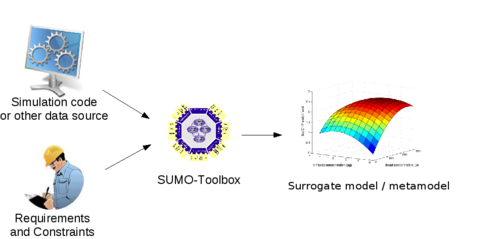Difference between revisions of "Main Page"
m (Modified 'Members' link according to updated SUMO website) |
|||
| (44 intermediate revisions by 4 users not shown) | |||
| Line 5: | Line 5: | ||
The Surrogate Modeling Toolbox (SUMO Toolbox) is a Matlab toolbox that automatically builds accurate [http://en.wikipedia.org/wiki/Surrogate_model surrogate models] (also known as metamodels or [http://en.wikipedia.org/wiki/Response_surface_methodology response surface models]) of a given data source (simulation code, data set, script, ...) within the accuracy and time constraints set by the user. In doing so the toolbox minimizes the number of data points (which it chooses automatically) since they are usually expensive. The toolbox tries to be as adaptive and autonomous as possible, requiring no user input besides some initial configuration. | The Surrogate Modeling Toolbox (SUMO Toolbox) is a Matlab toolbox that automatically builds accurate [http://en.wikipedia.org/wiki/Surrogate_model surrogate models] (also known as metamodels or [http://en.wikipedia.org/wiki/Response_surface_methodology response surface models]) of a given data source (simulation code, data set, script, ...) within the accuracy and time constraints set by the user. In doing so the toolbox minimizes the number of data points (which it chooses automatically) since they are usually expensive. The toolbox tries to be as adaptive and autonomous as possible, requiring no user input besides some initial configuration. | ||
| − | However, since there is no such thing as a ''one-size-fits-all'', the toolbox has been designed to be fully pluggable and extensible using standard [http://en.wikipedia.org/wiki/Object_orientation object oriented] design patterns. Implementations of the different components (model types, sampling strategies, model selection criteria, hyperparameter optimization algorithms,...) can be plugged-in, compared, or replaced by custom implementations. In this way the SUMO Toolbox provides a common platform to easily test and | + | [[Image:metamodel-generation.png|500 px|center|SUMO-Toolbox : Generating an approximation for a reference model]] |
| + | |||
| + | |||
| + | However, since there is no such thing as a ''one-size-fits-all'', the toolbox has been designed to be fully pluggable and extensible using standard [http://en.wikipedia.org/wiki/Object_orientation object oriented] design patterns. Implementations of the different components (model types, sampling strategies, model selection criteria, hyperparameter optimization algorithms,...) can be plugged-in, compared, or replaced by custom implementations. In this way the SUMO Toolbox provides a common platform to easily test and benchmark different sampling and approximation strategies while easily integrating in the engineering design process. [[About|more information....]] | ||
}}</div> | }}</div> | ||
| Line 15: | Line 18: | ||
* [[About#Screenshots|Screenshots]] | * [[About#Screenshots|Screenshots]] | ||
* [[About#Movies|Movies]] | * [[About#Movies|Movies]] | ||
| − | |||
* [[FAQ|Frequently Asked Questions - FAQ]] | * [[FAQ|Frequently Asked Questions - FAQ]] | ||
| Box2_title = [[Downloading|Download]] - [[Installation]] | | Box2_title = [[Downloading|Download]] - [[Installation]] | ||
| Line 23: | Line 25: | ||
* [[Installation|Installation instructions]] | * [[Installation|Installation instructions]] | ||
* [[License terms]] | * [[License terms]] | ||
| + | * [[Useful Links|Useful links]] | ||
| Box3_title = [[Running|Usage]] | | Box3_title = [[Running|Usage]] | ||
| Box3_contents = | | Box3_contents = | ||
| − | * [[Running|Running | + | * [[Running#Getting_started|Getting started]] |
| + | * [[Running|General usage]] | ||
* [[Configuration]] | * [[Configuration]] | ||
* [[Known bugs]] | * [[Known bugs]] | ||
| − | * [[Extending|Extending]] | + | * [[Extending|Extending the toolbox]] |
| − | * [[ | + | * [[Tips|Useful tips]] |
| − | |||
| − | |||
}} | }} | ||
| Line 42: | Line 44: | ||
| Box2_title = [[Feedback|Contact]] | | Box2_title = [[Feedback|Contact]] | ||
| Box2_contents = | | Box2_contents = | ||
| − | * [http://www.sumo.intec.ugent.be/ | + | * [http://www.sumo.intec.ugent.be/node/35 Project members] |
* [[Feedback]] | * [[Feedback]] | ||
| + | * [[Contributing]] | ||
* [[Reporting problems]] | * [[Reporting problems]] | ||
* [[Citing|Citing the toolbox]] | * [[Citing|Citing the toolbox]] | ||
Latest revision as of 14:38, 7 May 2013
|
SUrrogate MOdeling (SUMO) Toolbox |
|
The Surrogate Modeling Toolbox (SUMO Toolbox) is a Matlab toolbox that automatically builds accurate surrogate models (also known as metamodels or response surface models) of a given data source (simulation code, data set, script, ...) within the accuracy and time constraints set by the user. In doing so the toolbox minimizes the number of data points (which it chooses automatically) since they are usually expensive. The toolbox tries to be as adaptive and autonomous as possible, requiring no user input besides some initial configuration.
|
Open Positions
|
||
|---|---|---|
|
We are constantly looking for highly motivated PhD candidates or post-docs, that have a strong interest in one of our research topics. Our research area is highly multidisciplinary, and requires strong mathematical, physical and computer science knowledge. Please contact tom.dhaene@ugent.be |
- This website is under ongoing construction. Since it is a Wiki, you can help by contributing
